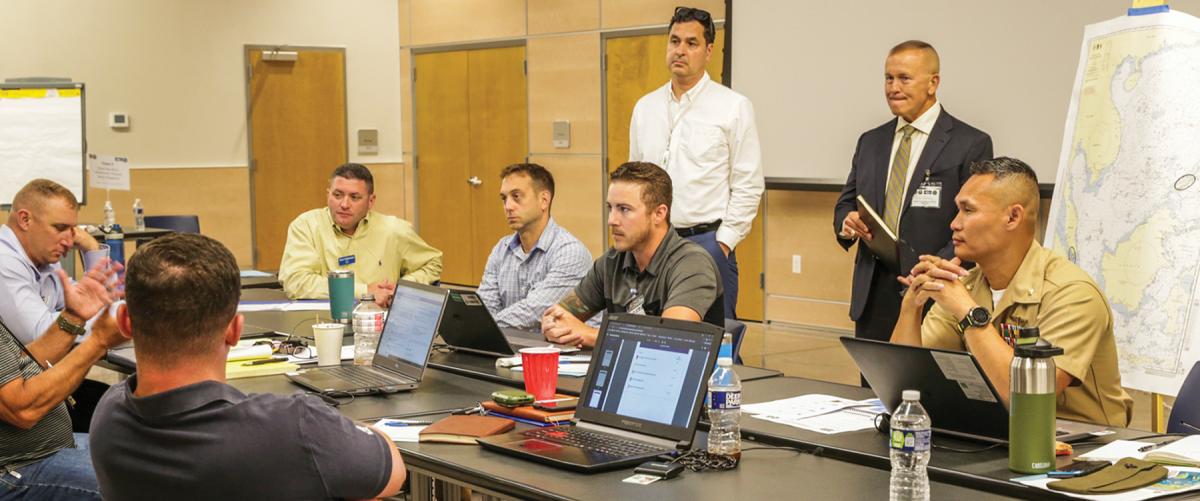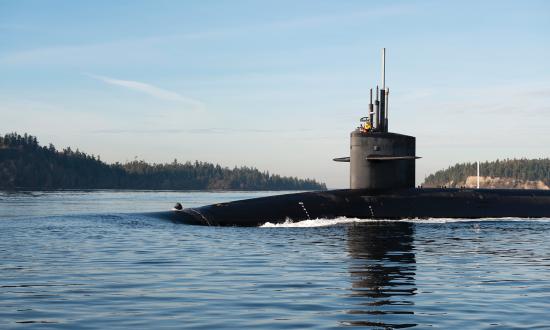Wargaming the “gray zone” is inherently challenging. Because nearly all wargame frameworks are predicated on kinetic interaction, few lend themselves to competitive interactions short of war in which the goal is to “win without fighting” through deterrence and assurance of allies and partners. Even fewer game systems address how new technologies affect competition. Consequently, insufficient attention has been paid to gaming possible ways of countering China’s harassment of Southeast Asian allies and partners below the threshold of violence.
The Wargame for Innovation and Frontline Improvisation (WIFI) seeks to fill this gap, offering a gaming forum to explore ways of countering malign aggression in competition short of conflict. WIFI brings together players from active-duty and science and technology professions to synthesize technology and operational concepts geared specifically to the maritime gray zone.
WIFI draws inspiration from retired Marine Corps Colonel Art Corbett, one of the principal authors of expeditionary advanced base operations (EABO) and related concepts, who encouraged the Navy and Marine Corps to seek forms of disruptive rather than sustaining innovation to regain the strategic initiative across the competition continuum. The predominant incremental, sustaining approach relies on marginal refinements of the current inventory of large, exquisite, and expensive platforms, despite their insufficient numbers and availability, while neglecting the intermediate force capabilities needed for success in the gray zone. This creates a form of cultural confirmation bias in competition phase wargames when players try to shoehorn familiar but ill-adapted tactics such as freedom of navigation operations and joint warfighting exercises to meet gray-zone challenges.
Gaming New Approaches
In contrast, Corbett sought to open new strategic opportunities to U.S. forces by supplementing or replacing large, brittle platforms with smaller, more agile, risk-worthy ones, leveraging emerging technology and new concepts such as EABO for their employment.1 In keeping with Corbett’s vision, WIFI encourages players to break from the tyranny of existing force structures and operational practices and apply design thinking to deter adversary aggression and assure allies and partners of U.S. commitment to the rule of international law.2
WIFI employs the maritime counterinsurgency theory of victory to help players familiarize themselves with the strategic logic of competition campaigns. Recontextualizing the nature of the challenge as an insurgency can shift how policymakers and commanders think about how U.S. forces can seek to win—and not just wait—in competition. Under the maritime counterinsurgency concept, the confidence of local civilian mariners in their ability to exercise their international legal rights in day-to-day operations is the primary factor in “who will ultimately confer victory in the battle between the competing legal regimes.”3 This framework helps players assess whether proposed technology options adequately deter adversaries and assure partners. Players must develop technology solutions that would achieve competition objectives without escalating to conflict.
Gray-zone wargame designers must choose how they will account for political and geopolitical realities, as these may dictate what success looks like to a much greater extent than in analyses of lethal engagements. For example, many games constrain players by accepting current U.S. policy for using proposed technologies or forces against adversaries short of war. Conversely, these games often discount or make unrealistic assumptions about uncomfortable or inconvenient political realities in allied and partner nations to avoid constraints on U.S. operational freedom of action.
WIFI takes a different approach. Game designers encourage players to push the boundaries in exploring how potential changes to authorities across the Department of Defense (DoD) and the Coast Guard could creatively enable a more effective deterrence posture. Under this mode of thinking, U.S. and internal DoD policy decisions are a variable that can be informed and influenced by developing a wider menu of technology and operational options.4 Policy-makers are invited to help remove existing policy barriers or encourage players to consider alternatives.
In addition, WIFI embraces, rather than papers over, the political and geopolitical complexities of the local operational theater in scenario development and gameplay. WIFI game scenarios are developed with extensive inputs from a diverse body of geopolitical experts, and players are educated about the context of the scenario to recognize potential limitations or strategic opportunities. For the WIFI pilot in July 2021, this process yielded a 2025 scenario that postulated an invitation from the Philippines to increase rotational U.S. forces to help counter Chinese coercion of Philippine civilian fishermen and resource extractors. A key driver was the Philippines’ real-world impending energy crisis when the Malampaya gas field dries up this decade. This forced players to work within a set of constraints similar to those found in the geopolitical environment today (rather than imagine unlikely political upheavals that would conveniently open previously neutral countries to U.S. presence) and devise solutions using technologies and forces that either already exist or are in advanced states of development and could be fielded on a short timeline.
In execution, the WIFI pilot saw Navy, Marine Corps, and Coast Guard operators and technologists from the naval research enterprise develop innovative concepts for U.S. forces to use technologies and transfer them to Philippine partners as part of a combined maritime counterinsurgency campaign. Two teams proposed deploying combined flotillas of manned and unmanned vessels equipped with a range of intermediate force capabilities to corrode, foul, interfere with, or annoy the Chinese Maritime Militia. This approach allowed U.S. forces to impose time, material, and morale costs without resorting to more escalatory kinetic tools.
A third team sought to empower the large numbers of Philippine civilian mariners plying the South China Sea every day to act as sensors and communications nodes, deploying small, modular Starlink-enabled sensor and communications packages on a variety of civilian vessels. This would enable civilians to call for help from U.S. and Philippine forces and backhaul location-tagged video and imagery to a Philippine-owned, U.S.-supported unclassified data center for strategic messaging to impose reputational costs on Chinese forces.5
Each of the teams’ proposed ideas were assessed as actionable and affordable, using existing or maturing technologies rather than reaching for aspirational technical revolutions. The game’s adjudication cell, composed of resource sponsors and subject matter experts on key technologies, Southeast Asian politics, and Chinese maritime strategy, viewed the teams’ proposals as disruptive to the adversary’s maritime insurgency strategy in ways that most current U.S. operations are not. In feedback, players said they came away with a better appreciation of the situation and why a maritime counterinsurgency strategy could achieve objectives in the gray zone without escalating to conflict.
WIFI offers a model for other efforts seeking to game gray-zone campaigning and foster technological and operational innovations in support of integrated deterrence. The next iteration of WIFI, this month, will refine this process and engage more key stakeholders. Disruptive innovation is essential to shaping the character of competition with China so U.S. forces can regain the strategic initiative.
1. Art Corbett, “The Military Innovator’s Dilemma,” BruteCast S2E2, The Krulak Center, 23 January 2021, www.youtube.com/watch?v=7r8Bk0wBZJo.
2. Hunter Stires, “The South China Sea Needs a ‘COIN’ Toss,” U.S. Naval Institute Proceedings 145, no. 5 (May 2019).
3. Hunter Stires, “Why We Defend Free Seas,” U.S. Naval Institute Proceedings 145, no. 5 (May 2019).
4. Department of the Navy, Advantage at Sea: Prevailing with Integrated All-Domain Naval Power, December 2020.
5. Holden Takahashi, “The World’s Fishermen as a Maritime Sensor Network,” U.S. Naval Institute Proceedings 148, no. 8 (August 2022).







